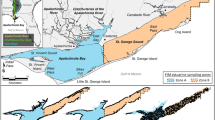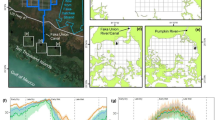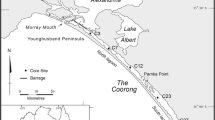Abstract
Corpus Christi Bay, one of seven major Texas estuaries, is characterized by low freshwater inflow, small tidal flushing, low annual rainfall, and high evaporation rates. Minimal exchange of water makes this estuary sensitive to episodic environmental variation caused by sudden surges of freshwater from flooding rains or hurricanes. It is suggested that this episodic variability stimulates estuarine production. For the last 11 years, detailed data have been collected on benthic community structure, primary and secondary productivity, and sediment nutrient regeneration which are combined with other information, such as fishery yields, into a reconstructed long-term data set. During this same period significant environmental changes in the estuary have been documented. In 1979 the lowest salinity recorded over the 11-year record was related to a short-term, high intensity rainfall. The benthos responded with abundance and biomass levels far greater than any other year during the study interval. Correlated with increased benthic production were large increases in shrimp yields. During more subtle changes with respect to freshwater input in 1981, significant alterations in primary productivity were quantified. Primary, secondary, and tertiary carbon production estimates derived from the reconstructed long-term data base indicated the benthos as a major link between primary producers and other consumers. Carbon flow from primary producers, however, appeared inadequate to support benthic production. Nutrient recycling was judged to provide more than 90% of nitrogen needed to support phytoplankton production and was considered a major factor influencing ecosystem function. The matching of biological responses to significant environmental changes in this estuary provided insight into ecosystem function and stressed the importance of short-term variability. Although recycling was identified as a major source of nutrients supporting primary production, it was concluded that episodic environmental change from freshwater input provided a much needed stimulus to productivity. These episodic changes replaced materials lost through recycling and sustained productivity over the long term.
Similar content being viewed by others
Literature Cited
Armstrong, N. E. 1982. Responses of Texas estuaries to freshwater inflow, p. 103–120. In V. S. Kenedy (ed.), Estuarine Comparisons. Academic Press, New York.
Barlow, J. P., C. J. Lorenzen, and R. T. Myren. 1963. Eutrophication of a tidal estuary. Limnol. Oceanogr. 8:251–262.
Bell, S. S., and B. C. Coull. 1978. Field evidence that shrimp predation regulates microfauna. Oecologia 35:141–148.
Boesch, D. F., R. J. Diaz, and R. W. Virnstein. 1976. Effects of Tropical Storm Agnes on soft-bottom macrobenthic communities of the James and York estuaries and the lower Chesapeake Bay. Chesapeake Sci. 17:246–259.
Copeland, B. J. 1966. Effects of decreased river flow on estuarine ecology. J. Water Poll. Cont. Fed. 38: 1831–1839.
Correll, D. L. 1978. Estuarine productivity. BioScience 28:646–650.
Flint, R. W. 1984. Phytoplankton production in the Corpus Christi Bay estuary. Contrib. Mar. Sci. 27: 65–83.
Flint, R. W., and N. N. Rabalais. 1981. Gulf of Mexico shrimp production: a food web hypothesis. Fish. Bull. 79: 737–748.
Flint, R. W., S. Rabalais, and R. Kalke. 1982. Estuarine benthos and ecosystem functioning, p. 185–201. In J. R. Davis (ed.), Recent Benthological Findings in Texas and Adjacent States. Texas Acad. Sci., Austin, TX.
Flint, R. W., and J. A. Younk. 1983. Estuarine benthos: long-term community structure variations, Corpus Christi Bay, Texas. Estuaries 6:126–141.
Flint, R. W., and D. Kamykowski. 1984. Benthic nutrient regeneration in south Texas coastal waters. Estuarine Coastal Shelf Sci. 19:221–230.
Fradette, P., and E. Bourget. 1980. Ecology of benthic epifauna of the estuary and Gulf of St. Lawrence: factors influencing their distribution and abundance on buoys. Can. J. Fish. Aquat. Sci. 37: 949–990.
Goldman, C. R. 1968. The use of absolute activity for eliminating serious errors in the measurement of primary productivity with 14C. J. Cons. Perm. Int. Explor. Mer. 32:172–179.
Gunter, G. 1962. Shrimp landings and production of the State of Texas for the period 1956–1959, with comparison with other Gulf states. Publ. Inst. Mar. Sci. Univ. Tex. 8:216–226.
Hargrave, B. T., and G. F. Connolly. 1978. A device to collect supernatant water for measurement of flux of dissolved compounds across sediment surfaces. Limnol. Oceanogr. 23:1005–1010.
Ho, C. L., and B. B. Barnett. 1977. Distribution of nutrients in Louisiana’s coastal waters influenced by the Mississippi River. Estuarine Coastal Mar. Sci. 5:173–195.
Holland, J. S., N. J. Maciolek, R. D. Kalke, L. Mullins, and C. H. Oppenheimer. 1975. A benthos and plankton study of the Corpus Christi, Copano and Aransas Bay systems. Rpt. to Texas Water Development Bd. from the Univ. Texas Mar. Sci. Inst. 174 p.
Moriarty, D. J. W. 1977. Quantification of carbon, nitrogen, and bacterial biomass in the food of some penaeid prawns. Aust. J. Mar. Freshw. Res. 28:113–118.
Moriarty, D. J. W., and M. C. Barclay. 1981. Carbon and nitrogen content of food and the assimilation efficiencies of penaeid prawns in the Gulf of Carpentaria. Aust. J. Mar. Freshw. Res. 32:245–251.
Nixon, S. W. 1981. Freshwater inputs and estuarine productivity, p. 31–57. In R. Cross and D. Williams (eds.), Proc. Nat. Symp. Freshwater Flow to Estuaries. U.S. Fish and Wildl. Serv., Off. Biol. Serv., Publ. #FWS/OBS-31/04.
Nixon, S. W., and M. E. Q. Pilson. 1983. Nitrogen in estuarine and coastal ecosystems, p. 565–648. In E. J. Carpenter and D. G. Capone (eds.), Nitrogen in the Marine Environment. Academic Press, New York.
Odum, E. P. 1971. Fundamentals of Ecology. W. B. Saunders Co., Philadelphia. 574 p.
Odum, H. T., R. P. Cuzon du Rest, R. J. Beyers, and C. Allbaugh. 1963. Diurnal metabolism, total phosphorus, Ohle anomaly, and zooplankton diversity of abnormal marine ecosystems of Texas. Publ. Inst. Mar. Sci. Univ. Tex. 9:404–453.
Oppenheimer, C. H., T. Isensee, W. B. Brodgen, and D. Bowman. 1975. Establishment of operational guidelines for Texas coastal zone management: biological uses criteria. Rpt. National Science Foundation, Grant #GI-34870X and Office Governor, Contract #IAC(74–75)0685, from Univ. Tex. Mar. Sci. Inst.
Peterson, D. H. 1979. Sources and sinks of biologically reactive oxygen, carbon, nitrogen, and silica in northern San Francisco Bay, p. 175–193. In T. J. Conomos (ed.), San Francisco Bay: The Urbanized Estuary. Allen Press, Lawrence, KS.
Redfield, S. C., B. H. Ketchum, and F. A. Richards. 1963. The influence of organisms on the composition of sea water, p. 27–77. In M. N. Hill (ed.). The Sea, Vol. 2. Wiley, New York.
Rowe, G. T., and K. L. Smith. 1977. Benthic-pelagic coupling in the Mid-Atlantic Bight, p. 55–66. In B. C. Coull (ed.), Ecology of Marine Benthos. Univ. South Carolina Press, Columbia.
Smith, N. P. 1977. Meteorological and tidal exchanges between Corpus Christi Bay, Texas and the northwestern Gulf of Mexico. Estuarine Coastal Mar. Sci. 5:511–520.
Smith, N. P. 1982. Tidal flushing of intracoastal bays. Contrib. Mar. Sci. 25:1–12.
Solorzano, L. 1969. Determination of ammmonia in natural waters by the phenolhypochlorite method. Limnol. Oceanogr. 14:799–801.
Stora, G., and A. Arnoux. 1983. Effects of large freshwater diversions on benthos of a Mediterranean lagoon. Estuaries 6:115–125.
Tenore, K. R. 1972. Macrobenthos of the Pamlico River estuary, North Carolina. Ecol. Monogr. 42: 51–69.
Texas Department of Water Resources. 1981. Nueces and Mission-Aransas estuaries: a study of the influence of freshwater inflows. Rpt. #LP-108, Texas Dept. Water Res., Austin.
Walsh, J. J. 1981. Shelf-sea ecosystems, p. 159–196. In A. R. Longhurst (ed.), Analysis of Marine Ecosystems. Academic Press, New York.
Author information
Authors and Affiliations
Additional information
Contribution No. 596 of The University of Texas Marine Science Institute and Contribution No. 18 of the State University of New York Research Center.
Rights and permissions
About this article
Cite this article
Flint, R.W. Long-term estuarine variability and associated biological response. Estuaries 8, 158–169 (1985). https://doi.org/10.2307/1351865
Received:
Accepted:
Issue Date:
DOI: https://doi.org/10.2307/1351865




